Weather forecast history
Being engaged in the forecasting of time series, I often come up with the idea: “I wish to implement such a forecasting model that takes everything into account and gives the most accurate forecast in the world”. Is it utopia? In response to this question, I plunged into the history of one of the most difficult questions of forecasting - weather forecasting.
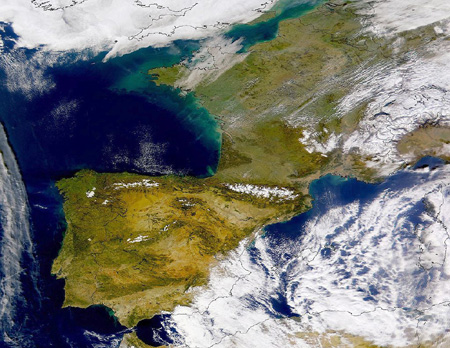
It is very likely that the weather forecast was the first forecast that interested people even in ancient times, when they were trying to guess the favorable conditions for sowing and growing agricultural structures. From such household observations of the weather, numerous national signs have grown. One Wikipedia offers us dozens will take about the weather . In particular, it is indicated that the sign is “information that is preserved among the people and is transmitted from generation to generation about various signs indicating the upcoming weather phenomena .” That is, the people observed the weather, put some of their observations into simplest patterns, on which the simplest forecast was built.
')
Even in the Middle Ages, during the period of development of navigation and geographical discoveries, not only navigation, but also the weather forecast interested seafarers. One of the first organizations that was supposed to deal with weather forecasting was the Meteorological Department, established in 1854 by the Trading Council of the Royal Society of England to assess the condition of sea routes. He was headed by the famous officer of the British fleet, Governor-General of New Zealand, Robert Fitzroy. He became one of the first meteorologists and is famous for being the first to provide forecasts to the general public. The first-ever weather forecast was published on August 1, 1860 in The Times, written by Robert Fitzroy. The date of publication in the English version is 1860, in the Russian - 1861. However, soon, on April 30, 1865, due to financial obligations, Fitzroy cut his throat with a razor. One of the versions of his suicide, however unlikely, is considered inaccuracy of his own weather forecasting.
At that stage, weather modeling remained below the limit of the possible, but comprehensive work was carried out to organize the collection of data on the current state of the atmosphere. In particular, 24 meteorological stations were organized throughout Europe, which exchanged data using Morse telegraph. In addition, weather forecasters learned how to make weather maps on which points with the same pressure value were connected by a line. Thus, the first “patterns” of cyclones and anticyclones were formed.
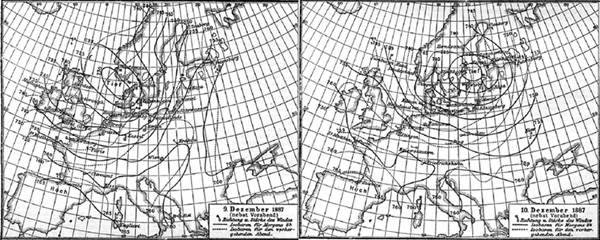
In the XIX century, the rapid development of thermodynamics and hydrodynamics. As a result, weather forecasting has also shifted to a new mathematical level of understanding the problem.
A pioneer in this area was the American meteorologist Cleveland Ebbe (Cleveland Abbe), whose first works in the field of meteorology date back to 1873. In his main work " The physical basis of long-range weather forecasting ", published in 1901 (*), he first attracted mathematics to solve the problem of weather forecasting: " Meteorology is an application to the atmosphere of the laws of hydrodynamics and thermodynamics ." There were no models for forecasting, but the first step in this direction has been made. Ebbe urged his colleagues: " Look at the problem of forecasting seriously and develop graphical, analytical and numerical methods for solving it."
* Publication dates and other details are taken from Peter Lynch’s article “ The History of the Development of Weather Forecasting Models ”, by Peter Lynch. Details in many cases differ from Wikipedia.
Immediately after, namely in 1904, the work of the Norwegian meteorologist Wilhelm Bjerknes was published (http://en.wikipedia.org/wiki/Vilhelm_Bjerknes) “ The problem of weather forecasting ”. In his work, the Norwegian went further than his predecessor and made an accurate statement of the problem of weather forecasting, dividing it into two steps.
Berkens was the first to identify 7 main variables describing the state of the atmosphere: pressure, temperature, density, humidity, and the three components of the air velocity. He also developed the first system of equations, the solution of which is provided by the weather forecast. The system included one equation for each dependent variable describing the atmosphere: three hydrodynamic equations of motion, the continuity equation, the equation of state, equations expressing the first and second law of thermodynamics.
The real innovator and inspirer of all subsequent generations of meteorologists was Lewis Fry Richardson , who was the first to apply numerical methods to integrate the system of equations of Berckens. He described in detail his experience of meteorological research in Weather Prediction by Numerical Process , published in 1922.
Paradoxically, but the main merit, and the main mistake of Richardson was one single numerical calculation of the predicted change in pressure at a particular point in Europe, which he cited in his book. On the one hand, this example was the first mathematical example of calculating the weather forecast. On the other hand, this example of calculation had an absolutely absurd result. According to the calculations of the scientist, the change in pressure after 6 hours should have been 14.5 kPa, which is an absurd value.
His calculation was correct, the error was incorrect initial conditions. The recalculation of the initial conditions that followed over the years showed that the algorithm proposed by Richardson is correct.
This famous example attracted ambitious mathematicians to his side, and he pushed all doubters away from his work. It took decades before the first comprehensive implementation of the Richardson mathematical model occurred.
The most frequently cited paragraph of his work is the description of the “Forecast Factory” (Richardson's Forecast factory).
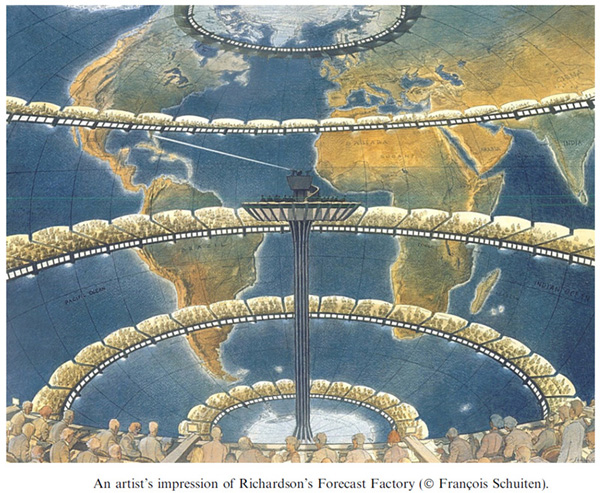
After the achievements of science in the field of numerical methods, inventions of the first electronic computers (computers), as well as the invention of the radiosonde to the ideas of Richardson returned. Famous mathematician John von Neumann returned to them with Julian Charney in the framework of the Electronic Computer Project on the basis of Princeton University in 1946.
As part of the project, one of the tasks to be solved was the problem of weather forecasting, which was led by Jule Charney. As a result of the work commissioned by the US Navy, the Electronic Numerical Integrator and Computer (ENIAC) was developed. The first mathematical weather forecast in 1950 was realized on this machine.
As part of the implementation of the Richardson model, of course, difficulties and additional restrictions arose, but the team led by Charney managed to overcome mathematical difficulties and get adequate results from the new system. The results of Charney's work were published from 1947 to 1955 and became the basis for the further development of mathematical modeling of the state of the atmosphere.
Following the success of the Princeton group, German meteorologists engaged in scientific research. In particular, in 1951, Karl-Heins Hinkelmann published the paper “ Ein numerisches Experiment mit den primitiven Gleichungen ”, in which he analyzed in detail the limitations that Charney had discovered and found an effective solution using the integration of so-called primitive equations. The successful implementation of the results of his work was carried out on the basis of the Meteorological Service of Germany in 1966.
Further, in 1956, Phillips published his work on global circulation atmospheric models. In these models, the entire surface of the earth was divided into rectangles (horizontal grid) and had a vertical size, most often given by absolute or relative pressure. All calculations in this model were based on the Richardson model.
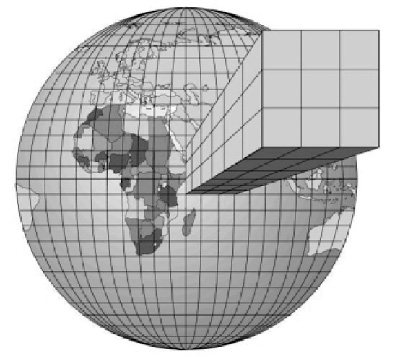
The circulation models developed by Phillips became a huge stage in the development of meteorology. Since then, this kind of model has become many times more complicated and increased. Today they are the basis for the formation of both short-term and long-term weather forecast.
Today, the European Center for medium-range weather forecasts (ECMWF) is a leader in the development and improvement of weather forecasting models.
ECMWF uses the most modern circulation model with the most complex interpretation of physical processes. The resolution of the model 25 is 25 km, it has 91 vertical levels. The initial conditions for the calculation are prepared by a four-dimensional scheme of assimilation, using data from satellites. All data are for 2007.
ECMWF makes the following forecasts: weather forecast for 10 days ahead, forecast for the month ahead, seasonal forecast over 6 months in advance. The ECMWF hardware is provided by IBM and is called High Performance Computing Facility (HPCF). HPCF includes two identical p690 + clusters. Each cluster consists of 68 servers, each of which has 32 CPUs with a frequency of 1.9 GHz. Peak performance is 16.5 teraflops per cluster.
According to the author's estimate, the “factory of forecasts” of Richardson would be able to compete in speed with the atmosphere with 64,000 people employed, that is, in 24 hours to make a forecast 24 hours in advance. The current ECMWF forecasting system is about 10 billion times more productive than the Richardson Forecast Factory.
People have been interested in the weather forecast for centuries, only 150 years ago this problem was approached comprehensively. Only 110 years ago, this task first received a mathematical description. Over the past century, the development of forecasting and modeling of the atmosphere has become revolutionary. However, this revolution required the tremendous efforts of the most talented mathematicians of the 20th century, as well as the inexhaustible investment in hardware and software.
The graph below shows how the quality of the weather forecast has improved over the years: from year to year, it becomes more accurate from model to model. To date, such a tremendous work has been done in the field of atmospheric modeling, which is breathtaking. And this work continues daily.
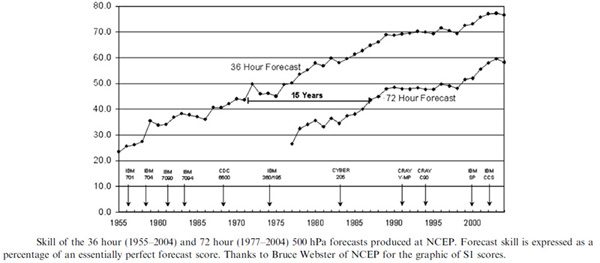
What is being modeled everywhere today, namely, economic systems, are much simpler systems than the atmosphere, because, as my boss said, “the first was created by man, while the second was created by God”. However, these systems have already grown and become so complicated that it is impossible to find the key to them in the shortest possible time.
Is it possible to build a system in which everything could be considered and predicted very accurately? The experience of developing mathematical models of the atmosphere shows that it is possible. And only constant research work, coupled with constant practice, for decades has been able to improve the quality of the forecast through the use of all improved models.
Unfortunately, my experience of communication on this topic shows that the forecast is needed very accurate, now, without delay, and many consider the investment both temporary and financial in the development of forecasting models as a waste of money.

First predictions
It is very likely that the weather forecast was the first forecast that interested people even in ancient times, when they were trying to guess the favorable conditions for sowing and growing agricultural structures. From such household observations of the weather, numerous national signs have grown. One Wikipedia offers us dozens will take about the weather . In particular, it is indicated that the sign is “information that is preserved among the people and is transmitted from generation to generation about various signs indicating the upcoming weather phenomena .” That is, the people observed the weather, put some of their observations into simplest patterns, on which the simplest forecast was built.
')
Seafarers Forecasts
Even in the Middle Ages, during the period of development of navigation and geographical discoveries, not only navigation, but also the weather forecast interested seafarers. One of the first organizations that was supposed to deal with weather forecasting was the Meteorological Department, established in 1854 by the Trading Council of the Royal Society of England to assess the condition of sea routes. He was headed by the famous officer of the British fleet, Governor-General of New Zealand, Robert Fitzroy. He became one of the first meteorologists and is famous for being the first to provide forecasts to the general public. The first-ever weather forecast was published on August 1, 1860 in The Times, written by Robert Fitzroy. The date of publication in the English version is 1860, in the Russian - 1861. However, soon, on April 30, 1865, due to financial obligations, Fitzroy cut his throat with a razor. One of the versions of his suicide, however unlikely, is considered inaccuracy of his own weather forecasting.
At that stage, weather modeling remained below the limit of the possible, but comprehensive work was carried out to organize the collection of data on the current state of the atmosphere. In particular, 24 meteorological stations were organized throughout Europe, which exchanged data using Morse telegraph. In addition, weather forecasters learned how to make weather maps on which points with the same pressure value were connected by a line. Thus, the first “patterns” of cyclones and anticyclones were formed.

The first mathematical approaches to weather forecasting
In the XIX century, the rapid development of thermodynamics and hydrodynamics. As a result, weather forecasting has also shifted to a new mathematical level of understanding the problem.
A pioneer in this area was the American meteorologist Cleveland Ebbe (Cleveland Abbe), whose first works in the field of meteorology date back to 1873. In his main work " The physical basis of long-range weather forecasting ", published in 1901 (*), he first attracted mathematics to solve the problem of weather forecasting: " Meteorology is an application to the atmosphere of the laws of hydrodynamics and thermodynamics ." There were no models for forecasting, but the first step in this direction has been made. Ebbe urged his colleagues: " Look at the problem of forecasting seriously and develop graphical, analytical and numerical methods for solving it."
* Publication dates and other details are taken from Peter Lynch’s article “ The History of the Development of Weather Forecasting Models ”, by Peter Lynch. Details in many cases differ from Wikipedia.
Immediately after, namely in 1904, the work of the Norwegian meteorologist Wilhelm Bjerknes was published (http://en.wikipedia.org/wiki/Vilhelm_Bjerknes) “ The problem of weather forecasting ”. In his work, the Norwegian went further than his predecessor and made an accurate statement of the problem of weather forecasting, dividing it into two steps.
- The step of diagnosing the current state of the weather.
- Weather forecast step for the time interval ahead.
Berkens was the first to identify 7 main variables describing the state of the atmosphere: pressure, temperature, density, humidity, and the three components of the air velocity. He also developed the first system of equations, the solution of which is provided by the weather forecast. The system included one equation for each dependent variable describing the atmosphere: three hydrodynamic equations of motion, the continuity equation, the equation of state, equations expressing the first and second law of thermodynamics.
Richardson's Idea for Weather Forecast
The real innovator and inspirer of all subsequent generations of meteorologists was Lewis Fry Richardson , who was the first to apply numerical methods to integrate the system of equations of Berckens. He described in detail his experience of meteorological research in Weather Prediction by Numerical Process , published in 1922.
Paradoxically, but the main merit, and the main mistake of Richardson was one single numerical calculation of the predicted change in pressure at a particular point in Europe, which he cited in his book. On the one hand, this example was the first mathematical example of calculating the weather forecast. On the other hand, this example of calculation had an absolutely absurd result. According to the calculations of the scientist, the change in pressure after 6 hours should have been 14.5 kPa, which is an absurd value.
His calculation was correct, the error was incorrect initial conditions. The recalculation of the initial conditions that followed over the years showed that the algorithm proposed by Richardson is correct.
This famous example attracted ambitious mathematicians to his side, and he pushed all doubters away from his work. It took decades before the first comprehensive implementation of the Richardson mathematical model occurred.
The most frequently cited paragraph of his work is the description of the “Forecast Factory” (Richardson's Forecast factory).
Imagine a large hall, similar to the theater's auditorium, but the lounges of the Benoir and the amphitheater go exactly in a circle and occupy the place where the stage is usually located. The walls of this room are painted in such a way as to represent the surface of the earth. The ceiling represents the North Pole, the UK in the gallery, the tropics on the mezzanine floor, Australia in the lower wardrobe area, and the Antarctic on the floor. On calculating the weather, myriads of calculators work on every point of the earth (computer in those years meant a man-calculator), but each calculator solves only one equation or even part of the equation. The work of the whole region is coordinated by a high ranking official. Numerous indicators (night signs) continuously reflect the results of calculations in such a way that neighboring computers can use them. Thus, the complete calculation from north to south is performed consistently. There is a huge column on the floor, halfway up the half of the hall, on its top is a pulpit. In this department, there sits a man who leads the whole theater, he is surrounded by numerous assistants and envoys. His main duty is to maintain the speed of calculations constant. He is very similar to the conductor, but instead of musicians, he runs numerous computers. And the place of the conductor’s wand is in his hands a ray pointer: he is shining pink on what should be counted right now, and blue on what will be counted immediately after.

The development of forecasting models in the middle of the XX century
After the achievements of science in the field of numerical methods, inventions of the first electronic computers (computers), as well as the invention of the radiosonde to the ideas of Richardson returned. Famous mathematician John von Neumann returned to them with Julian Charney in the framework of the Electronic Computer Project on the basis of Princeton University in 1946.
As part of the project, one of the tasks to be solved was the problem of weather forecasting, which was led by Jule Charney. As a result of the work commissioned by the US Navy, the Electronic Numerical Integrator and Computer (ENIAC) was developed. The first mathematical weather forecast in 1950 was realized on this machine.
As part of the implementation of the Richardson model, of course, difficulties and additional restrictions arose, but the team led by Charney managed to overcome mathematical difficulties and get adequate results from the new system. The results of Charney's work were published from 1947 to 1955 and became the basis for the further development of mathematical modeling of the state of the atmosphere.
Following the success of the Princeton group, German meteorologists engaged in scientific research. In particular, in 1951, Karl-Heins Hinkelmann published the paper “ Ein numerisches Experiment mit den primitiven Gleichungen ”, in which he analyzed in detail the limitations that Charney had discovered and found an effective solution using the integration of so-called primitive equations. The successful implementation of the results of his work was carried out on the basis of the Meteorological Service of Germany in 1966.
Further, in 1956, Phillips published his work on global circulation atmospheric models. In these models, the entire surface of the earth was divided into rectangles (horizontal grid) and had a vertical size, most often given by absolute or relative pressure. All calculations in this model were based on the Richardson model.

The circulation models developed by Phillips became a huge stage in the development of meteorology. Since then, this kind of model has become many times more complicated and increased. Today they are the basis for the formation of both short-term and long-term weather forecast.
Modern weather forecasting systems
Today, the European Center for medium-range weather forecasts (ECMWF) is a leader in the development and improvement of weather forecasting models.
ECMWF uses the most modern circulation model with the most complex interpretation of physical processes. The resolution of the model 25 is 25 km, it has 91 vertical levels. The initial conditions for the calculation are prepared by a four-dimensional scheme of assimilation, using data from satellites. All data are for 2007.
ECMWF makes the following forecasts: weather forecast for 10 days ahead, forecast for the month ahead, seasonal forecast over 6 months in advance. The ECMWF hardware is provided by IBM and is called High Performance Computing Facility (HPCF). HPCF includes two identical p690 + clusters. Each cluster consists of 68 servers, each of which has 32 CPUs with a frequency of 1.9 GHz. Peak performance is 16.5 teraflops per cluster.
According to the author's estimate, the “factory of forecasts” of Richardson would be able to compete in speed with the atmosphere with 64,000 people employed, that is, in 24 hours to make a forecast 24 hours in advance. The current ECMWF forecasting system is about 10 billion times more productive than the Richardson Forecast Factory.
Conclusion
People have been interested in the weather forecast for centuries, only 150 years ago this problem was approached comprehensively. Only 110 years ago, this task first received a mathematical description. Over the past century, the development of forecasting and modeling of the atmosphere has become revolutionary. However, this revolution required the tremendous efforts of the most talented mathematicians of the 20th century, as well as the inexhaustible investment in hardware and software.
The graph below shows how the quality of the weather forecast has improved over the years: from year to year, it becomes more accurate from model to model. To date, such a tremendous work has been done in the field of atmospheric modeling, which is breathtaking. And this work continues daily.

What is being modeled everywhere today, namely, economic systems, are much simpler systems than the atmosphere, because, as my boss said, “the first was created by man, while the second was created by God”. However, these systems have already grown and become so complicated that it is impossible to find the key to them in the shortest possible time.
Is it possible to build a system in which everything could be considered and predicted very accurately? The experience of developing mathematical models of the atmosphere shows that it is possible. And only constant research work, coupled with constant practice, for decades has been able to improve the quality of the forecast through the use of all improved models.
Unfortunately, my experience of communication on this topic shows that the forecast is needed very accurate, now, without delay, and many consider the investment both temporary and financial in the development of forecasting models as a waste of money.
Source: https://habr.com/ru/post/179687/
All Articles